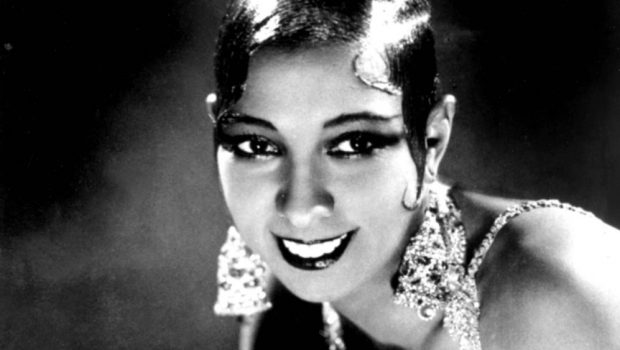Josephine Baker’s Prismatic Sisters
Words by Terri Simone Francis
Josephine Baker (1906-1975) was an American-born French actress and music hall phenomenon who starred in four feature films: Siren of the Tropics (1927), Zouzou (1934), Princess Tam Tam (1935) and The French Way (1945). Though she was a pioneering figure in film history, Baker was too part of a luminous constellation of African American actresses, dancers, and musicians whose work deserves recognition. Some are well-known and others are less familiar.
Evelyn Preer
Within Our Gates, Oscar Micheaux, 1920. In this silent-era race film (a genre of films made before the 1950s that prioritized a black perspective), Evelyn Preer plays Sylvia Landry, an African-American teacher advocating for school funding amid personal complexities in her love life as well as the politics of sharecropping and its legacy within her family. Compared to Josephine Baker’s roles, Preer’s characters were middle-class women closely associated with education, writing, and political advocacy. In contrast, the French-speaking actress played women who, while gifted, moved in the realm of show business and held low-wage jobs. Within Our Gates addressed grim histories of lynching and rape as the main character sorts through dilemmas and desires around her fiancé and their jealous mutual friend. Preer’s films were serious while Baker’s were comedies that involved dance as well as physical comedy.
Josephine Baker
Siren of the Tropics, Mario Nalpas and Henri Étiévant, 1927. Baker stars as the silly and sexy Papitou in this silent-era musical comedy set in the West Indies and in Paris. From our vantage point today, we can see that Baker’s circle in the United States included women filmmakers such as Eloyce Gist and Zora Neale Hurston who wielded the medium for their purposes of evangelism and ethnography respectively. Meanwhile Baker explored her authorship primarily through the cultivation of her signature visual, singing and dancing presence. She further expressed her ideas and built her brand through a number of co-written projects such as her 1931 novella Mon sang dans tes veines (My Blood in Your Veins), recounted to and adapted by Félix de la Camara and Pepito Abatino, Joséphine Baker’s magazine whose surviving April 1927 is held at Syracuse University, and Les mémoires de Joséphine Baker (1927) where she wrote dreamily of having a cinema at home. Baker drew from the rags to riches version of her life’s story for the basis of her films.
Nina Mae McKinney
Hallelujah, King Vidor, 1929. Although Josephine Baker’s international debut in Siren of the Tropics occurred in 1927, Nina Mae McKinney deserves the honor of being recognized as the first African-American woman to lead a mainstream American film production. Vidor was nominated for an Oscar for his direction and McKinney was offered a five-year contract with MGM. Though her potential was not fully realized due to racism and racist production codes in Hollywood, her talent and ambition remain evident in the work she did produce. Chick, the character she plays in Hallelujah, is simply mesmerizing and McKinney’s energy comes through wonderfully. Chick represents, among other things, the lure of the city and its pleasures both material and carnal. For her naïve lover and the mark in her con game, she is the classic temptress within a specifically spiritual context. The film has plenty to offer in terms of showcasing black talent and black musical forms. McKinney infused Chick with a sense of tragedy and sensual energy that makes me want to see her co-star with Baker as two con artists on the take!
Bessie Smith
St. Louis Blues, Dudley Murphy, 1929. Baker’s direct exposure to the blues came primarily through her role as dresser to singer Clara Smith on tour during the early years of her career before Paris. But it’s worth taking a closer look at the phenomenon of the blues woman performer because of its profound significance to understanding the erotic, daring, and traveling aspects of Baker’s cinematic prism. In 1929, singer Bessie Smith appeared in St. Louis Blues (not to be confused with the feature film starring Nat King Cole and Ruby Dee) as her only film performance, singing her version of the W.C. Handy song “St. Louis Blues.” Not too different from today’s music videos, St. Louis Blues was a short film built around pre-existing source material and the scenarios featured songs and promoted the performer. Here the song is about Bessie’s relationship with a two-timing good-time fella who takes advantage of her money and leaves her for another woman. In the film Bessie mourns the end of the relationship, pleads with him to come back, and generally ruminates on the whole sad affair as only a blues woman could do. Ultimately Baker developed a glamorous and mainstream-oriented performance style that incorporated both American and European elements with black diasporic influences.
Katherine Dunham
Katherine Dunham was a renowned dancer, anthropologist and pedagogue who revolutionized the dance world in the 1930s and 1940s. She formed an early all-African-American ballet company and went on to establish her own school, the Katherine Dunham School of Dance and Theatre in New York City. Dunham performs as herself with her dance troupe in the film Stormy Weather (1943), with Lena Horne and Bill “Bojangles” Robinson in the principal roles. Dunham and Baker moved in related but very different dance and cultural circles. Not taking away from Baker’s devotion to her dance practice, but it is important to point out that she was self-taught and relied on a secret formula of signature moves and improvisations. Dunham by contrast was a University of Chicago graduate in the field of anthropology. She would develop choreography based on her own studies of dance in Jamaica, Martinique and Trinidad and Tobago, sponsored by Guggenheim and Rosenwald fellowships. Where Baker was received in a framework of naturalness and comedy, Dunham was an academic and her work was based on scholarly investigation. Where Baker performed a mashup that drew movements, both imagined and observed from a variety of dance cultures, Dunham’s choreography was specific and historically grounded.
—
Though based in Paris, Baker remained connected to a special group of women whose careers emerged around the same time while they lived on the other side of the Atlantic and worked in various modes. In addition to those discussed above, more notables include Louise Beavers and Fredi Washington in Imitation of Life (1934), Hattie McDaniel who was the first African American to be nominated for and win an Oscar (Gone with the Wind 1939), Elisabeth Welch who established her career in Britain (Song of Freedom) and Dorothy Dandridge who is known for her romantic and steamy portrayals in Carmen Jones and Island in the Sun where she played opposite Harry Belafonte. Ethel Waters’ multifaceted career as an actress and singer would seem to be a model of Baker’s own.
The women in Baker’s circle of African American stardom share the phenomenon of the cinematic prism. At times their careers took a shape that was similar to Baker’s in that it was international and involved film, music, and dance. Due to racism and economic necessity, many performers developed multiple products as Baker did. Yet Baker was unique in the way she could bounce her stage performances, public persona, and screen characters off of each other, creating a multidimensional, liminal, and somewhat mysterious but totally stand-out film presence.
Author bio: Terri Francis is the author of Josephine Baker’s Cinematic Prism. She is Associate Professor of Cinema and Media Studies and Director of the Black Film Center/Archive at Indiana University. Her essays appear in Transition, Salon, and Another Gaze.
Tweet






























